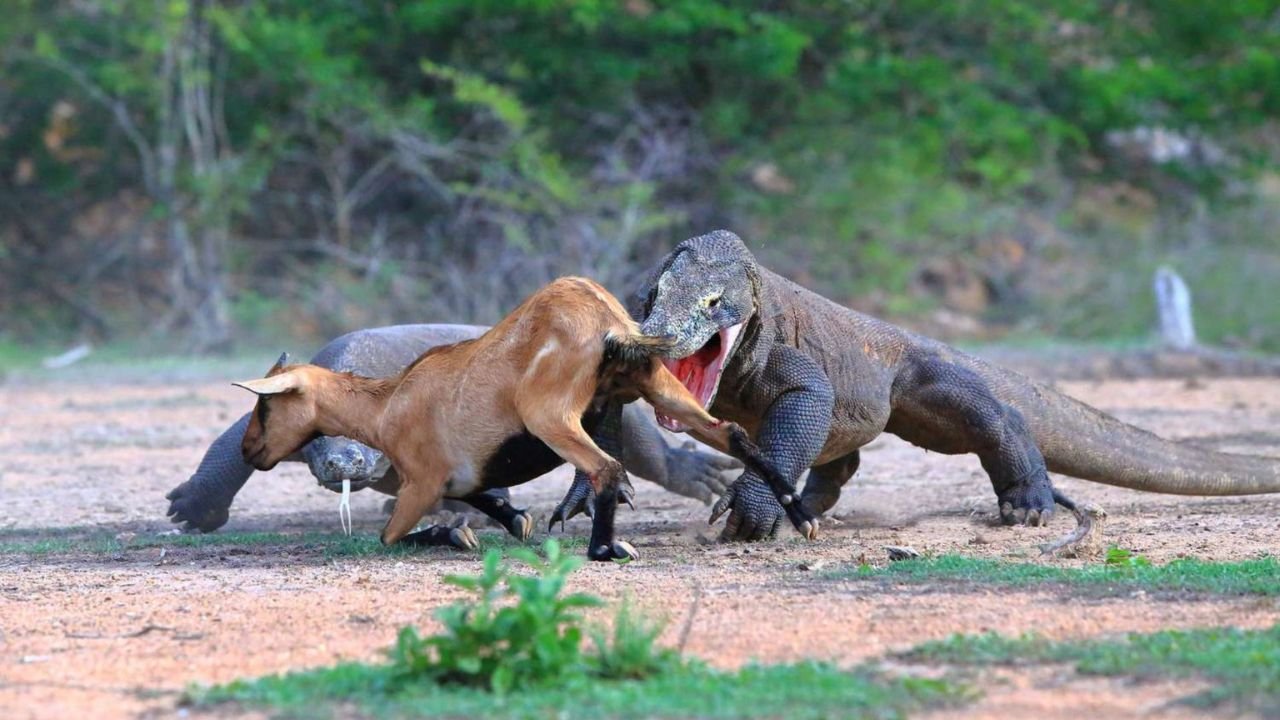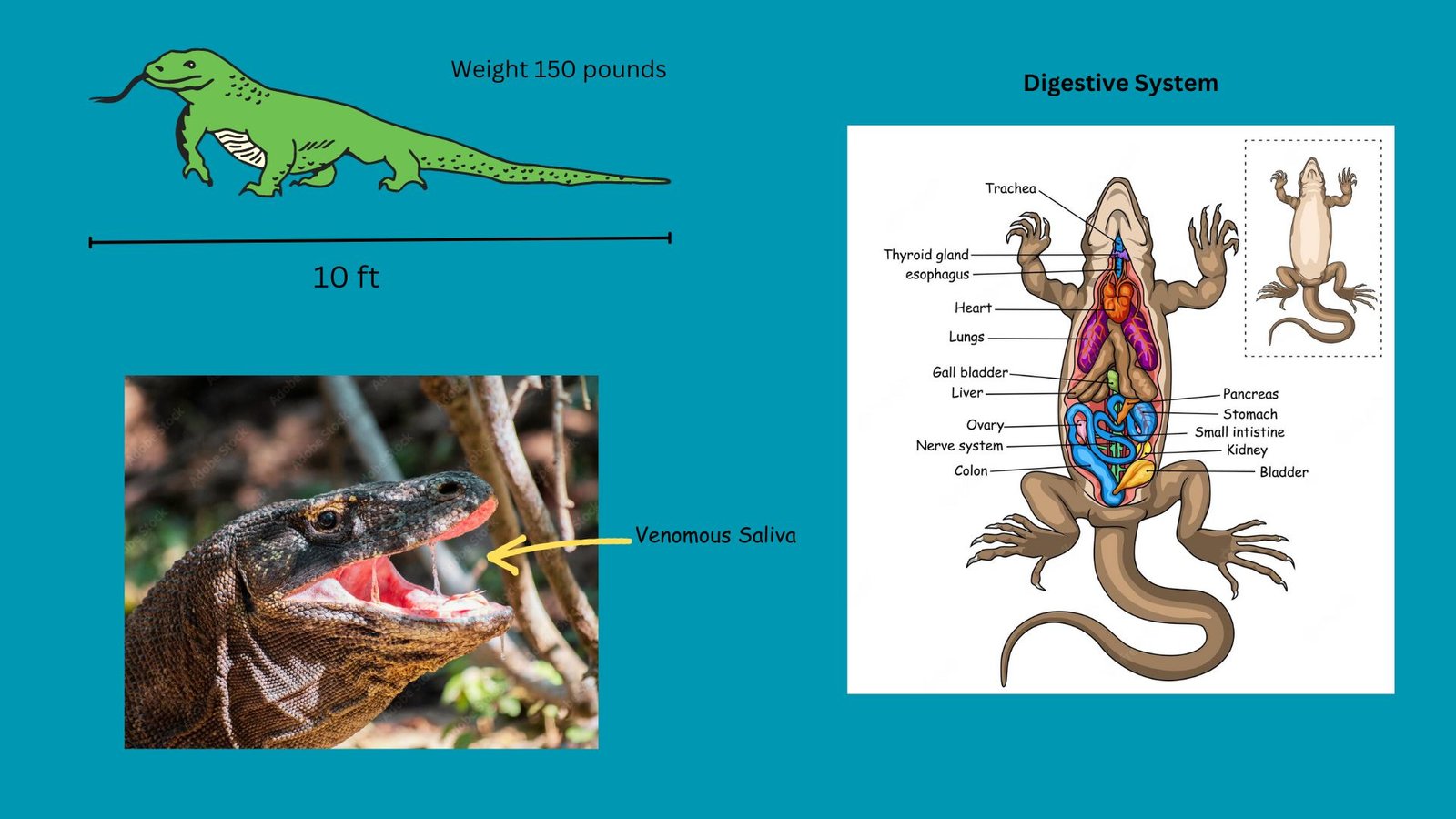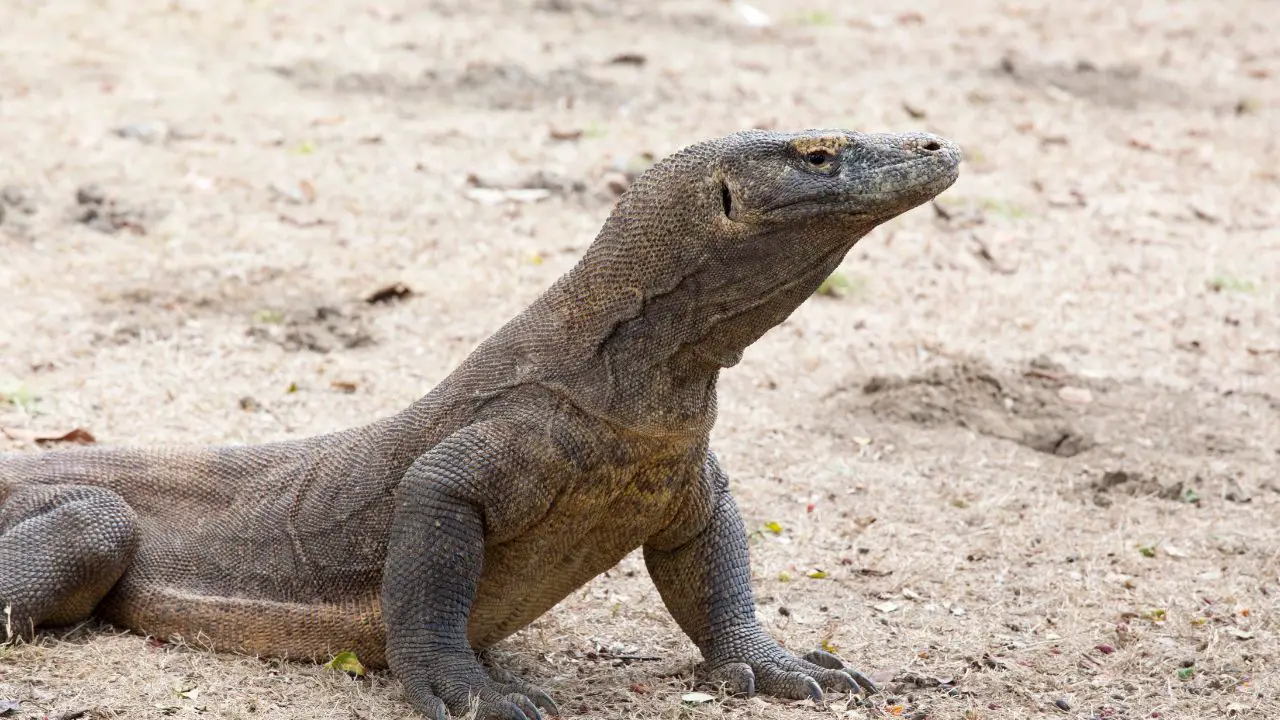Komodo dragons, the largest living lizards on Earth, have always been surrounded by a cloud of intrigue and fear. A significant part of this fear stems from the longstanding question: do Komodo dragons eat people? This query has not only sparked curiosity but also ignited debates among experts and enthusiasts alike.
In this article, we aim to address this pressing question head-on, without meandering into the general characteristics of these creatures. Through a meticulous exploration of historical incidents, scientific studies, and expert opinions, we will attempt to separate fact from fiction. Are humans a part of their diet, or is it just a myth amplified by fear and speculation?
Do Komodo Dragons Eat People
Historical Incidents of Komodo Dragons Attacking Humans

Komodo dragons, primarily found in the Indonesian islands, are known for their powerful build and predatory nature. While they mostly feed on deer, pigs, and smaller dragons, there have been instances where they have attacked humans. Here, we delve into some verified historical incidents involving Komodo dragon attacks on humans:
- 2007 Attack in Komodo National Park: In 2007, an 8-year-old boy was tragically attacked and killed by a Komodo dragon in Komodo National Park. This incident brought global attention to the potential dangers of interacting with these creatures in the wild.
- 2009 Attack on a Fisherman: In another unfortunate event in 2009, a fisherman was attacked by a Komodo dragon on Komodo Island. Despite the efforts of the locals to save him, the fisherman succumbed to his injuries.
- 2017 Attack on a Tourist: In a more recent incident in 2017, a tourist was severely injured after getting bitten by a Komodo dragon. The tourist survived, but the incident served as a reminder of the caution needed when visiting areas inhabited by these creatures.
- Park Ranger Attacks: Over the years, several park rangers have reported being attacked or threatened by Komodo dragons. These incidents underscore the importance of maintaining a safe distance from these animals and adhering to safety guidelines when visiting their habitats.
While these incidents are relatively rare, they highlight the potential danger that Komodo dragons can pose to humans. It is essential to approach these creatures with caution and respect for their natural behavior and habitat.
The Diet of Komodo Dragons: Do They Include Humans?

Komodo dragons are known for their voracious appetite and are considered to be carnivorous predators. Their diet primarily consists of carrion, which means they often feed on the dead bodies of animals. However, they are also known to hunt live prey, including deer, pigs, and smaller Komodo dragons. But the pressing question we are addressing here is – do they include humans in their diet?
- Natural Diet: In their natural habitat, Komodo dragons predominantly feed on large mammals like deer and wild boars. They have also been observed eating smaller members of their species. Their powerful jaws and sharp teeth allow them to tear flesh easily, making them efficient predators.
- Incidents Involving Humans: As we discussed in the previous section, there have been several documented cases of Komodo dragons attacking humans. However, it is essential to note that these incidents are more of an exception rather than a rule. Komodo dragons do not naturally prey on humans, and such incidents are relatively rare.
- Expert Opinions: According to experts, humans are not a regular part of the Komodo dragon’s diet. These creatures usually avoid human settlements and prefer to stay in their natural habitats. The attacks on humans have often been attributed to provocation or accidental encounters.
- Scientific Studies: Scientific studies on the diet of Komodo dragons have shown that their primary food sources are wild animals found in their habitat. There is no substantial evidence to suggest that they have a preference for human flesh or that humans are a part of their regular diet.
In conclusion, while Komodo dragons have been involved in isolated incidents where they have attacked humans, it is not accurate to state that humans are a part of their regular diet. These majestic creatures primarily feed on wild animals, and interactions with humans are generally uncommon.
Expert Opinions on Komodo Dragons’ Behavior Towards Humans
Komodo dragons, with their prehistoric appearance and predatory nature, have often been the subject of much fascination and fear. To understand their behavior towards humans better, let’s explore what experts have to say:
- Natural Behavior: Experts agree that Komodo dragons are naturally wary of humans. In their natural habitat, these creatures prefer to avoid human interaction, showcasing a tendency to retreat rather than engage when they encounter humans.
- Reasons for Attacks: According to herpetologists, the specialists in studying reptiles, attacks on humans are generally rare and occur under specific circumstances. These might include accidental encounters where the dragon feels threatened or provoked, or in situations where their natural prey is scarce.
- Conservationists’ Observations: Conservationists working in the Komodo National Park have noted that the dragons are more accustomed to human presence in areas frequented by tourists. However, they maintain a safe distance, and aggressive behavior towards humans is not commonly observed.
- Zoologists’ Insights: Zoologists have studied the behavior of Komodo dragons in captivity and noted that with proper management and safety measures, these creatures can coexist with humans without significant issues. They emphasize the importance of understanding the dragons’ behavior patterns to prevent potential conflicts.
- Safety Guidelines: Experts in the field strongly recommend adhering to safety guidelines when visiting areas inhabited by Komodo dragons. This includes maintaining a safe distance, not provoking the animals, and being accompanied by trained guides who understand the creatures’ behavior.
In conclusion, the consensus among experts is that Komodo dragons do not naturally exhibit aggressive behavior towards humans. The incidents of attacks are isolated and often occur under specific circumstances. Through understanding and respecting their natural behavior, the chances of conflict can be significantly reduced.
Safety Measures to Prevent Komodo Dragon Attacks on Humans
While encounters with Komodo dragons are relatively rare, ensuring safety is paramount when venturing into areas where these majestic creatures reside. Here, we outline some verified safety measures that can help prevent potential attacks on humans:
- Maintain a Safe Distance: Experts recommend maintaining a safe distance from Komodo dragons at all times. Observing these creatures from afar allows you to appreciate their beauty without provoking them or putting yourself at risk.
- Guided Tours: When visiting habitats of Komodo dragons, it is advisable to opt for guided tours. Trained guides are familiar with the dragons’ behavior patterns and can ensure a safe and informative experience.
- Avoid Feeding: Feeding the dragons can alter their natural behavior and make them associate humans with food, increasing the risk of attacks. It is strictly prohibited to feed Komodo dragons in the wild.
- Proper Waste Management: Ensuring proper disposal of waste can prevent attracting Komodo dragons to human settlements. These creatures have a keen sense of smell and can be drawn to areas with food remnants.
- Wearing Appropriate Clothing: Wearing sturdy, closed shoes and long trousers can provide a basic level of protection during an unexpected encounter. It’s also recommended to avoid bright colored clothing as it can attract the dragons.
- Emergency Protocols: Being aware of the emergency protocols and having a first-aid kit handy can be beneficial in the unlikely event of an attack. Quick response can prevent severe injuries.
- Educational Programs: Participating in educational programs can provide valuable insights into the behavior of Komodo dragons and tips on how to coexist with them safely.
In conclusion, while the risk of an attack is minimal, adhering to these safety measures can further reduce the potential dangers associated with interacting with Komodo dragons. Remember, safety comes first, and respecting the natural habitat and behavior of these creatures is key to a safe and enjoyable experience.
The Anatomy of Komodo Dragons: Are They Capable of Eating Humans?

When discussing the potential for Komodo dragons to eat humans, it’s essential to consider their physical attributes and capabilities. Let’s explore the anatomy of Komodo dragons to understand whether they are capable of consuming humans:
- Size and Strength: Komodo dragons are the largest living species of lizards, with some individuals measuring up to 10 feet in length and weighing around 150 pounds. Their substantial size and muscular build give them the physical capacity to overpower not only smaller prey but also larger animals, including humans.
- Jaw Structure: These creatures possess a powerful jaw structure equipped with sharp, serrated teeth that can tear through flesh with ease. Their bite force, combined with a swift striking speed, makes them formidable predators.
- Digestive System: The digestive system of a Komodo dragon is highly efficient, capable of digesting bones, hooves, and horns. While humans are not a regular part of their diet, their digestive system is technically capable of processing human flesh.
- Venomous Saliva: Recent studies have shown that Komodo dragons have venomous saliva containing toxins that can induce shock and prevent blood clotting in their prey. This venom can be a potent weapon when they decide to attack.
- Hunting Tactics: Komodo dragons are ambush predators, meaning they rely on stealth and surprise to capture their prey. Their hunting tactics involve lying in wait and launching a sudden attack, which could potentially be lethal to humans if encountered in the wild.
In conclusion, while it is not common for Komodo dragons to prey on humans, their anatomy suggests that they are more than capable of doing so if the circumstances align. It is crucial to approach these creatures with caution and respect, acknowledging their potential danger while also appreciating their role in the ecosystem.
Eyewitness Accounts of Komodo Dragon Attacks on Humans
While Komodo dragon attacks on humans are relatively rare, they have occurred, leaving a lasting impact on the victims and witnesses alike. In this section, we bring to light some eyewitness accounts that shed light on the nature of these attacks:
- 2001 Attack on a Local: In 2001, a Komodo dragon attacked a local resident on Komodo Island. Eyewitnesses recounted the swift and sudden nature of the attack, emphasizing the dragon’s speed and power. The victim survived but sustained severe injuries.
- 2007 Attack on a Child: The 2007 attack on an 8-year-old boy in Komodo National Park was witnessed by several people. Eyewitnesses described the harrowing event, where the dragon appeared from the bushes and attacked the child. Despite immediate intervention, the boy could not be saved.
- 2009 Fisherman Incident: In the 2009 incident involving a fisherman, witnesses recounted the dragon’s aggressive behavior and the tragic outcome despite efforts to rescue the victim. The incident served as a grim reminder of the potential dangers of encountering a Komodo dragon in the wild.
- Tour Guides’ Experiences: Tour guides in the Komodo National Park have shared numerous accounts of close encounters with Komodo dragons. While most of these encounters have been non-aggressive, guides emphasize the importance of maintaining a safe distance and following safety guidelines to prevent potential attacks.
- Documented Video Footages: There have been instances where attacks or aggressive behaviors have been captured on video, providing firsthand visual accounts of the dragons’ capabilities and behaviors. These footages serve as a potent reminder of the need for caution when in proximity to these creatures.
In conclusion, eyewitness accounts of Komodo dragon attacks on humans highlight the necessity for vigilance and adherence to safety protocols when visiting areas inhabited by these creatures. These accounts serve as a testament to the potential dangers posed by Komodo dragons, urging us to approach them with respect and caution.
Scientific Studies on Komodo Dragons’ Predatory Behavior Towards Humans
Scientific studies have played a crucial role in understanding the predatory behavior of Komodo dragons, especially in relation to human encounters. Let’s delve into what the scientific community has discovered about these magnificent creatures:
- Predatory Behavior: Scientific research has shown that Komodo dragons are primarily carrion eaters, but they are also capable predators that can hunt a wide range of prey. While humans are not a regular part of their diet, their predatory instincts can be triggered under certain circumstances.
- Venomous Bite: Earlier theories suggested that the bacteria in a Komodo dragon’s mouth were responsible for the potency of their bite. However, recent studies have revealed that they possess venom glands that can deliver a cocktail of toxins, causing shock and preventing blood clotting in their prey.
- Habitat and Human Interaction: Studies conducted in their natural habitat have shown that Komodo dragons generally avoid human settlements. The instances of attacks on humans are relatively rare and usually occur when the dragons feel threatened or provoked.
- Conservation Efforts: Scientific research has also focused on conservation efforts to protect Komodo dragons and their habitats. These studies emphasize the importance of maintaining a balanced ecosystem where humans and dragons can coexist without conflict.
- Safety Measures: Based on scientific observations, guidelines have been developed to ensure the safety of visitors in areas inhabited by Komodo dragons. These guidelines stress the importance of maintaining a safe distance and not provoking the animals to prevent potential attacks.
In conclusion, scientific studies have provided valuable insights into the predatory behavior of Komodo dragons towards humans. While they possess the physical attributes to pose a threat to humans, incidents of attacks are relatively rare, and with proper safety measures, the risks can be minimized.







Leave a Reply